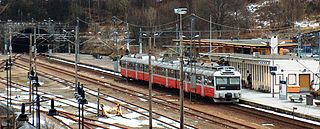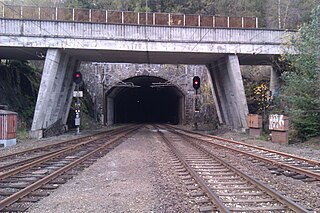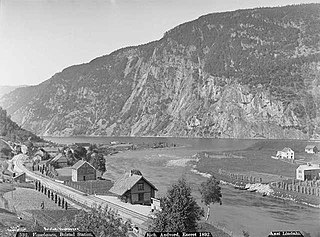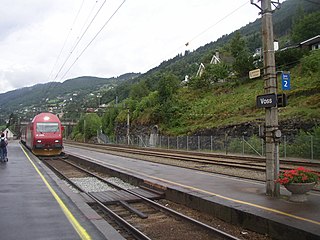Related Research Articles

The Norwegian railway system comprises 4,109 km of 1,435 mm track of which 2,644 km is electrified and 274 km double track. There are 697 tunnels and 2,760 bridges.

The Jæren Line was a 74.7-kilometer (46.4 mi) long railway line between Stavanger and Egersund in Jæren, Norway. The name is no longer in official use and the section is regarded as the westernmost part of the Sørlandet Line. Owned by Bane NOR, the line has double track from Stavanger Station to Sandnes Station, and single track from Sandnes to Egersund Station. The line is electrified at 15 kV 16.7 Hz AC and equipped with centralized traffic control and GSM-R. The line is served by the Jæren Commuter Rail and intercity trains along the Sørlandet Line, both operated by Go-Ahead Norge. CargoNet runs container freight trains on the line, which terminate at Ganddal Freight Terminal.

Vygruppen, branded as Vy, formerly the Norwegian State Railways, is a government-owned railway company which operates most passenger train services and many bus services in Norway. The company is owned by the Norwegian Ministry of Transport. Its sub-brands include Vy Buss coach services, CargoNet freight trains and the Swedish train transport company Tågkompaniet. In 2009, NSB carried 52 million train passengers and 104 million bus passengers. On 24 April 2019, passenger train and bus services were rebranded as Vy.

The Bergen Line, or the Bergen Railway, is a 371-kilometre (231 mi) long scenic standard gauge railway line between Bergen and Hønefoss, Norway. The name is often applied to the entire route from Bergen to Oslo, including the Randsfjord and Drammen lines between Hønefoss and Oslo, covering a total distance of 496 kilometres (308 mi). It is the highest mainline railway line in Northern Europe, crossing the Hardangervidda plateau at 1,237 metres (4,058 ft) above sea level.

The Flåm Line is a 20.2-kilometer (12.6 mi) long railway line between Myrdal and Flåm in Aurland Municipality, in Vestland county, Norway. A branch line of the Bergen Line, it runs through the valley of Flåmsdalen and connects the mainline with Sognefjord. The line's elevation difference is 866 meters (2,841 ft); it has ten stations, twenty tunnels and one bridge. The maximum gradient is 5.5 percent (1:18). Because of its steep gradient and picturesque nature, the Flåm Line is now almost exclusively a tourist service and has become the third-most visited tourist attraction in Norway.

Hallingskeid Station is a train station on the Bergen Line in the municipality of Ulvik in Vestland county, Norway. Located at an elevation of 1,110 meters (3,640 ft) above mean sea level, the station is situated inside a snow tunnel. It opened along with the central section of the line on 10 June 1908 and remained as a staffed station until 1982. It is located on the Hardangervidda plateau in an area without population or road access. The station therefore serves trekkers and mountaineers. Only some of the Vy Tog trains stop at the station.

Arna Station is a train station in Bergen, Norway; located in the Arna borough on the east side of Ulriken and between the two tunnels Ulriken Tunnel and Arnanipa. The present station was opened in 1964, when the tunnels were completed. The old station, located north of the new station, is still in use for heritage trains on Gamle Vossebanen.

The Old Voss Line is a heritage railway between Garnes and Midttun near Bergen, Norway.

Vy Gjøvikbanen AS is a Norwegian railway company that operates the passenger train service on the Gjøvik Line. A subsidiary of the state-owned Vy, it operates a fleet of nine Class 69g three-car electric multiple units. NSB Gjøvikbanen provides two different services: the Skøyen – Oslo S – Jaren service is part of the Oslo Commuter Rail; while Oslo S – Gjøvik is a regional service, with only limited stops on the route until Grua. Departures are each 40 minutes, with every third train running to Gjøvik.

The Asker Line is a 9.5-kilometre (5.9 mi) railway line between Asker and Lysaker in Norway. The line runs along the same corridor as the Drammen Line, offering increased capacity, speed and regularity on the rail network west of Oslo. The first part opened in 2005, and in 2011 an extension opened from Sandvika to Lysaker. Original plans called for an extension to Skøyen, but from 2020, new planning is under way for an extension all the way to Oslo Central Station. Most of the railway is in tunnel and is dimensioned for 160 km/h (99 mph) running. The entire railway is electrified at 15 kV 16.7 Hz AC. The first section cost 3.7 billion kr, while the second is budgeted at NOK 2.7 billion.

The Ulriken Tunnel is a railway tunnel on the Bergen Line between Bergen Station and Arna Station in Bergen Municipality in Vestland county, Norway.

The Trøndelag Commuter Rail is a commuter train service operating in Trøndelag county, Norway. It was operated with Class 92 diesel multiple units by Vy, until 7 June 2020, when SJ Norge took over the contract until 2030. The service provides a commuter service connecting Trondheim to its suburbs, between towns in Innherred and as an airport rail link for Trondheim Airport, Værnes. Although passenger services have operated along the lines since 1864, the commuter train was created with an increase of service with existing rolling stock in 1993. In 2019, the system was used by 1.4 million passengers.

Bergen Light Rail is a light rail system in Bergen, Norway. The first stage of the project was a twenty-station stretch between the city center and Nesttun, where the first 15 stations comprising a 9.8-kilometre (6.1 mi) stretch opened in 2010, and the second was a 3.6-kilometre (2.2 mi) stretch from Nesttun to Lagunen which opened in June 2013. A third stretch from Lagunen to Bergen Airport, Flesland opened in 2017. The second line between Kaigaten and Fyllingsdalen opened on 21 November 2022. Further plans for the project involve mooted extensions to Åsane and Storavatnet.

Sandvika Station is a railway station located at Sandvika in Bærum, Norway. Situated on the Drammen Line, 14.14 kilometers (8.79 mi) from Oslo S, it also an intermediate station of the Asker Line. Vy serves the station with local and regional, with about 7,000 passengers using the station daily. It is also served by the Airport Express Train and serves as the main bus terminal for the town. The station is elevated and has two island platforms and four tracks.

Oslo Commuter Rail is a commuter rail centered in Oslo, Norway, connecting the capital to six counties in Eastern Norway. The system is operated by Vy and its subsidiary Vy Gjøvikbanen, using Class 69 and Class 72 electric multiple units (EMU). The network spans eight routes and 128 stations, with Oslo Central Station (Oslo S) as the central hub. The trains run on 553 kilometers (344 mi) of electrified mainline railway owned by the Bane NOR. Deficits are financed by the Norwegian Ministry of Transport, although the network also has a ticketing cooperation with Ruter, the public transport authority in Oslo and Akershus. The network is the longest commuter rail network in the Nordic countries, and among top ten in Europe.

Bolstadøyri Station is located on Bergensbanen railway line located in the village of Bolstadøyri in the municipality of Voss, in Vestland county, Norway. The station is served by twelve daily departures per direction by the Bergen Commuter Rail operated by Vy Tog. The station opened in 1883 as part of Vossebanen.

Voss Station is a railway station on the Bergen Line located in the village of Vossevangen in the municipality of Voss in Vestland county, Norway. It sits just off the European route E16 highway on the northwestern shore of the lake Vangsvatnet.

The Ringerike Line is a proposed 40-kilometre (25 mi) extension of the Bergen Line from Jong, Sandvika to Hønefoss, Norway. In 2022, the project was postponed; the government has no commitment to any timeframe.

The Voss Line is a railway line from Bergen to Voss in Vestland, Norway. It opened on 11 July 1883 and was extended to Oslo as the Bergen Line on 27 November 1909. It was built as 1,067 mm narrow gauge, but converted to 1,435 mmstandard gauge with the connection with the Bergen Line. It was electrified in 1954, and shortened by the Ulriken Tunnel in 1963.
The Arna Tunnel was a proposed road tunnel which would run from Arna through the mountain Ulriken to Minde or Nygårdstangen in Bergen, Norway. It was planned to have two tubes, four lanes, and would be 8 kilometres (5.0 mi) long. It would shorten the distance of European Road 16 (E16) between Bergen and Arna by 15 kilometres (9.3 mi).
References
- ↑ "Eventyrlig passasjervekst på jernbanen". www.banenor.no. 29 July 2020. Retrieved 24 December 2021.
- ↑ Otterlei, Simen Sundfjord (2017-08-29). "Se gjennombruddet for ny tunnel på Bergensbanen: – En stor begivenhet". NRK (in Norwegian Bokmål). Retrieved 2019-06-09.
